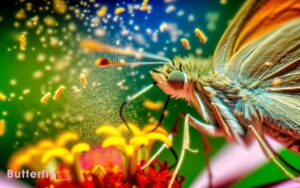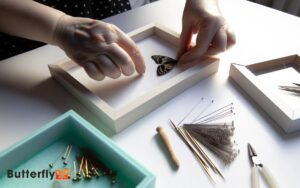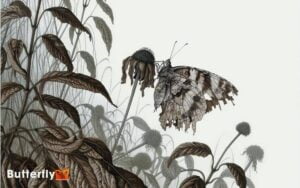Do Rabbits Eat Butterfly Bushes? Discover the Facts!
Rabbits typically avoid butterfly bushes, known as Buddleia, due to their high alkaloid content, making them unappetizing.
As herbivores, rabbits primarily seek out tender greens and vegetables, focusing on high-fiber foods to prevent gastrointestinal stasis. Butterfly bushes don’t fall within their dietary preferences, which include plants like lettuce, kale, and dandelions.
To safeguard your garden, consider deterrent methods such as fencing and companion planting. Adopting these strategies can effectively manage rabbit interactions. Want to explore additional methods for protecting your garden from rabbits?

Key Takeaways
Rabbit Dietary Habits
Rabbits are primarily herbivores, consuming a diet rich in fibrous plant material such as grasses, leaves, and certain vegetables.
You’ll find that their gastrointestinal tract is specially adapted to process cellulose, which is abundant in their natural diet. This diet guarantees their digestive system remains healthy and functional.
Research indicates that high fiber content is essential for preventing gastrointestinal stasis, a common and potentially fatal condition in rabbits.
When you feed them, focus on providing hay, which should constitute the bulk of their diet. Leafy greens and vegetables, like kale and carrots, can supplement their primary food sources.
Avoid feeding them high-sugar or starchy foods, as these can disrupt their delicate digestive balance and lead to obesity.
Butterfly Bush Characteristics
Commonly known as Buddleia, butterfly bushes are perennial shrubs celebrated for their vibrant, fragrant flowers that attract a variety of pollinators, including butterflies and bees.
These shrubs are native to Asia, Africa, and the Americas, and they thrive in well-drained soils with full sunlight. Their rapid growth and hardy nature make them a popular choice for ornamental gardening.
Key characteristics of butterfly bushes include:
- Flower Structure: Dense clusters of tubular flowers.
- Bloom Time: Long blooming period from summer through fall.
- Growth Habit: Can grow up to 6-12 feet in height.
- Leaf Arrangement: Lance-shaped leaves that are oppositely arranged.
Understanding these features will help you appreciate why Buddleia is a staple in many gardens.
Common Garden Pests
Gardeners often face numerous challenges when dealing with common garden pests that can damage or destroy their carefully cultivated plants.
Aphids, for instance, are small sap-sucking insects that can cause significant stress to plants by transmitting viruses and depleting nutrients.
Slugs and snails, known for their nocturnal activity, consume young leaves and stems, leaving unsightly holes.
Spider mites, almost invisible to the naked eye, feed on plant juices, leading to stippling and discoloration.
Additionally, Japanese beetles are notorious for skeletonizing foliage by eating the tissue between leaf veins.
Effective pest management strategies include regular monitoring, introducing natural predators, and utilizing organic insecticides.
Rabbit Eating Preferences
You should know that rabbits exhibit distinct dietary preferences, typically favoring tender greens, vegetables, and certain flowers.
However, evidence suggests that butterfly bushes, or Buddleia, aren’t particularly appealing to them. Studies indicate that while butterfly bushes provide abundant nectar, they do not offer the pollen that many bee species need to thrive. As a result, the relationship between the butterfly bush and bee attraction is weaker compared to native flowering plants that support a wider range of pollinators. Gardeners looking to attract more bees may want to consider planting a variety of native flowers alongside their butterfly bushes.
Scientific observations indicate that rabbits tend to avoid plants with tough, woody stems and high alkaloid content, which butterfly bushes possess.
Common Rabbit Foods
Rabbits exhibit a diverse diet, often favoring tender greens, fruits, and vegetables, while occasionally sampling a variety of ornamental plants. Their dietary preferences are driven by nutritional needs and palatability.
You’ll find rabbits particularly drawn to:
- Lettuce and Kale: High in water content and easily digestible, these leafy greens are a staple.
- Carrots and Apples: Rich in sugars and vitamins, they provide essential nutrients and are highly palatable.
- Clover and Dandelions: These wild forages are nutrient-dense and readily available in many environments.
- Herbs like Parsley and Basil: Aromatic and flavorful, they offer medicinal benefits and enrich the diet.
Understanding these preferences helps you comprehend the complex feeding behavior of rabbits, ensuring you can better manage their interaction with your garden.
Butterfly Bush Appeal
Fascinatingly, evidence suggests that butterfly bushes (Buddleja spp.) aren’t a preferred food source for rabbits due to their relatively low palatability and potential mild toxicity.
When analyzing rabbit eating preferences, you’ll notice they tend to favor plants high in nutritional value and palatable foliage.
Butterfly bushes contain iridoid glycosides, which can deter herbivory through their bitter taste and mild toxicity. This makes them less attractive compared to other lush, nutrient-rich plants.
Additionally, the coarse texture of Buddleja leaves might be unappealing to rabbits, who prefer tender, easily digestible vegetation. If you’re concerned about rabbit damage in your garden, butterfly bushes could be a safer choice because of their natural deterrent properties.
Signs of Rabbit Damage
One of the most telling signs of rabbit damage on butterfly bushes is the presence of clean, angled cuts on stems and leaves, indicating the precise and sharp incisors of these herbivores.
You might notice other indicators as well:
- Nibbling on lower branches: Rabbits typically feed close to the ground, so look for damage on the lower sections.
- Missing young shoots: Tender new growth is particularly appealing to rabbits, often disappearing overnight.
- Rabbit droppings: Small, round fecal pellets near the base of your bushes can confirm their presence.
- Tracks in soil: Look for small, four-toed footprints in the soil around your plants.
Identifying these signs helps you understand the extent of the damage and informs your next steps.
Natural Rabbit Repellents
To protect your butterfly bushes from rabbits, consider using organic deterrents like predator urine or garlic sprays, which exploit the animals’ acute sense of smell.
Plant-based repellents, such as marigolds or lavender, can also provide a natural barrier due to their strong odors.
Additionally, you can create effective DIY repellent recipes using household ingredients like vinegar and hot pepper.
Organic Deterrent Options
Frequently, gardeners turn to organic deterrent options like natural rabbit repellents to protect their butterfly bushes from hungry rabbits. Understanding the science behind these methods can greatly enhance your garden’s resilience.
Here are four effective organic deterrents:
- Blood Meal: High in nitrogen, blood meal deters rabbits due to its strong odor, which they find unappealing.
- Garlic Spray: The sulfur compounds in garlic emit a pungent smell that repels rabbits while being safe for plants.
- Hot Pepper Spray: Capsaicin, found in hot peppers, acts as an irritant, deterring rabbits when applied to foliage.
- Hair Clippings: Human or pet hair can be spread around the garden; its scent signals the presence of predators, discouraging rabbits.
Utilize these strategies to maintain your garden’s integrity.
Plant-Based Repellents
Plant-based repellents like lavender, marigold, and mint not only beautify your garden but also effectively deter rabbits due to their strong, unappealing scents. Lavender (Lavandula spp.) emits linalool, a terpene that rabbits find repellent.
Marigold (Tagetes spp.) secretes thiophene, a sulfur-containing compound that deters herbivores. Mint (Mentha spp.) produces menthol, which disrupts a rabbit’s olfactory receptors, making your garden less inviting.
These plants create a multi-sensory barrier that guards your butterfly bushes from rabbit predation. Scientific studies have shown that integrating these aromatic plants into your landscape reduces herbivore activity, preserving your garden’s integrity.
DIY Repellent Recipes
Creating your own natural rabbit repellents can be an effective and eco-friendly way to protect your butterfly bushes from these herbivores.
Here are some evidence-based recipes you can try:
- Garlic Spray: Blend 3-4 cloves of garlic with water and a few drops of dish soap. Strain the mixture and spray it on your plants.
- Hot Pepper Solution: Mix 1 tablespoon of cayenne pepper with 1 quart of water. Add a few drops of dish soap to help it adhere to leaves.
- Egg Mixture: Combine 2 eggs with a quart of water. Spray this on foliage; the scent deters rabbits.
- Herbal Infusion: Steep rosemary, sage, and thyme in boiling water. Let it cool, strain, and spray on your bushes.
These natural repellents exploit rabbits’ aversion to strong scents and tastes, ensuring your butterfly bushes remain unharmed.
Fencing and Barriers
To effectively protect your butterfly bushes from rabbits, installing sturdy fencing or barriers is crucial. Use galvanized wire mesh with a maximum mesh size of 1 inch to prevent rabbits from squeezing through.
Make sure the fence height is at least 2 feet above ground and bury it 6 inches deep to prevent burrowing.
A hardware cloth cylinder around individual plants also offers strong protection. Research indicates that physical barriers are among the most effective deterrents, greatly reducing plant damage. Regularly inspect for breaches and repair promptly.
Employing these scientifically-backed methods will create a formidable defense, safeguarding your butterfly bushes from rabbit predation. Consistent maintenance ensures long-term effectiveness, giving your plants the best chance to thrive.
Companion Planting
When considering companion planting for butterfly bushes, you should focus on plant pairing benefits, such as enhanced growth compatibility and natural pest control.
Scientific studies show that certain plants can repel rabbits and other pests, reducing the need for chemical interventions.
Additionally, compatible plants can optimize nutrient uptake and improve overall garden health.
Plant Pairing Benefits
Companion planting with butterfly bushes can enhance biodiversity and deter pests, creating a more resilient garden ecosystem. By strategically pairing plants, you can optimize growth conditions and leverage natural synergies.
Specifically, you might consider these benefits:
- Enhanced Pollination: Butterfly bushes attract pollinators, boosting fruit set for nearby crops.
- Soil Health: Legumes fix nitrogen, enriching the soil for butterfly bushes.
- Pest Deterrence: Aromatic herbs like rosemary can mask the scent of butterfly bushes, reducing pest attraction.
- Microclimate Regulation: Tall plants provide shade and wind protection, stabilizing the microenvironment.
Natural Pest Control
Strategic companion planting leverages natural predator-prey relationships to manage pests, reducing the need for chemical interventions.
By planting specific flora together, you can attract beneficial insects that prey on harmful pests. This technique, backed by evidence-based research, optimizes your garden’s health and biodiversity.
For instance, planting marigolds near butterfly bushes can deter nematodes, while lavender can repel moths and fleas.
Here’s a quick guide:
| Companion Plant | Benefit to Butterfly Bush |
|---|---|
| Marigold | Nematode deterrence |
| Lavender | Repels moths and fleas |
| Yarrow | Attracts predatory insects |
| Basil | Repels aphids and mites |
| Nasturtium | Aphid trap crop |
Using these combinations, you can naturally control pests and foster a thriving garden ecosystem.
Growth Compatibility
Incorporating growth compatibility in your garden guarantees that butterfly bushes and their companion plants thrive symbiotically, maximizing health and productivity.
Butterfly bushes (Buddleja spp.) flourish when paired with plants that enhance soil nutrients, deter pests, and create beneficial microenvironments.
Here’s how to optimize your planting strategy:
- Alliums: Plants like garlic and onions release sulfur compounds, which repel pests that could harm butterfly bushes.
- Lavender: Its aromatic oils deter pests while attracting pollinators, enhancing butterfly bush vitality.
- Yarrow: This plant improves soil quality by adding essential nutrients, benefiting butterfly bushes.
- Marigolds: Known for their pest-repellent properties, marigolds protect butterfly bushes from harmful insects.
Safe Pest Control Methods
Using safe pest control methods guarantees that you protect your butterfly bushes without harming the environment or beneficial insects.
Opt for organic deterrents like neem oil, which acts as an effective insect repellent without toxic residue.
You can also use diatomaceous earth to target pests; its microscopic, abrasive particles damage insects’ exoskeletons, leading to dehydration.
Additionally, consider introducing natural predators such as ladybugs or lacewings. These beneficial insects prey on harmful pests, maintaining ecological balance.
For rabbits, deploy physical barriers like chicken wire or hardware cloth around your bushes.
Employing these methods assures your garden thrives while adhering to environmental stewardship.
Always monitor for pest activity and apply treatments as needed, ensuring minimal intervention for maximal benefit.
Long-Term Garden Maintenance
Ensuring the longevity of your butterfly bushes requires diligent soil management, regular pruning, and vigilant monitoring for emerging pests and diseases.
Effective long-term garden maintenance involves several critical steps:
- Soil Management: Enrich soil with organic matter to maintain ideal pH levels and promote healthy root systems.
- Pruning: Conduct annual pruning in late winter or early spring to encourage vigorous growth and enhance blooming.
- Pest Monitoring: Regularly inspect for aphids, spider mites, and caterpillars, implementing integrated pest management strategies when necessary.
- Disease Prevention: Watch for signs of fungal infections like powdery mildew and apply appropriate fungicides preemptively.
Conclusion
To sum up, safeguarding your butterfly bushes from rabbits is crucial for maintaining a thriving garden. By identifying signs of rabbit damage and implementing measures like fencing and companion planting, you can outsmart these common pests.
Employing safe pest control methods guarantees that your garden remains a haven for both plants and beneficial insects. Think of your garden as a fortress; with the right defenses, it will flourish against any invader. Your vigilance will pay off in lush, vibrant blooms.







Thank you for your sharing. I am worried that I lack creative ideas. It is your article that makes me full of hope. Thank you. But, I have a question, can you help me?
Your article helped me a lot, is there any more related content? Thanks!
I don’t think the title of your article matches the content lol. Just kidding, mainly because I had some doubts after reading the article.
Can you be more specific about the content of your article? After reading it, I still have some doubts. Hope you can help me.
Thanks for shening. I read many of your blog posts, cool, your blog is very good.
Thank you for your sharing. I am worried that I lack creative ideas. It is your article that makes me full of hope. Thank you. But, I have a question, can you help me?
Your article helped me a lot, is there any more related content? Thanks!